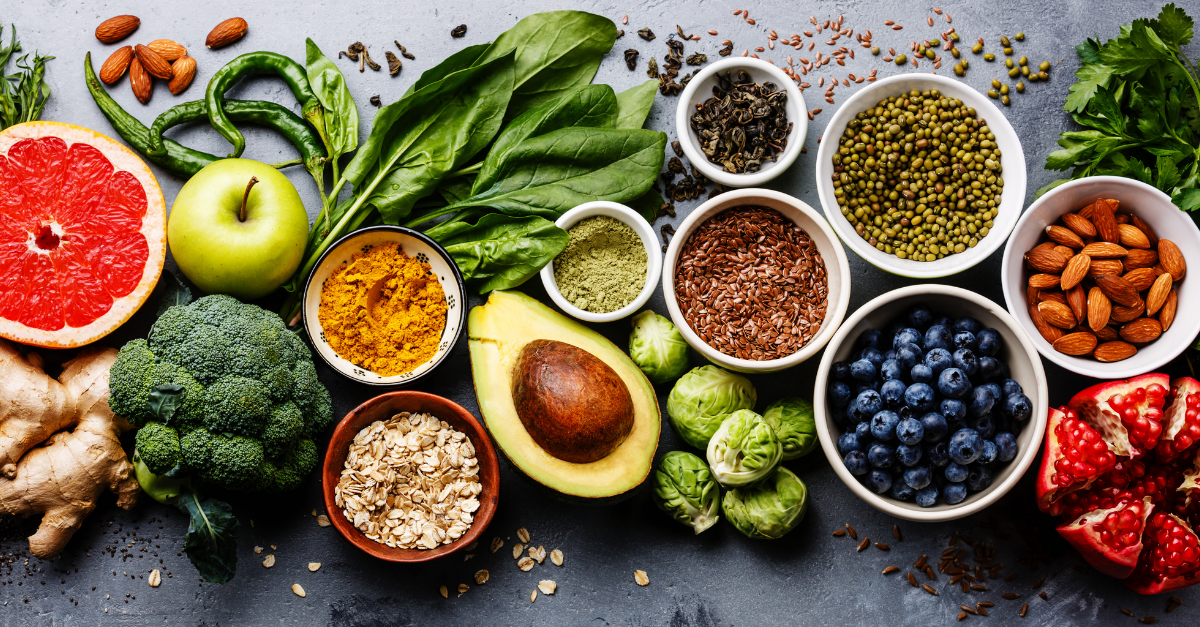According to science, the secret to living longer may involve eating more fiber. From whole grains and fruits to legumes and nuts, plant foods are rich in fiber and offer a plethora of health benefits that can help prevent chronic diseases, improve overall health, and aid with weight management [4, 16]. Plant foods have many health-boosting qualities, but fiber is one of the biggest reasons they pack such powerful benefits. Getting enough fiber is critical for many aspects of health, but can this carbohydrate improve longevity? Before we get into the details of how fiber exerts its superpowers, let’s start by understanding what it is and why getting enough of it is essential for your health.
What is fiber?
Dietary fiber is a type of carbohydrate that your body cannot digest. Unlike other forms of carbohydrates (such as starches), fiber doesn’t break down into digestible sugar molecules, which means it passes through the digestive system relatively intact. Fun fact: Even though it’s on every nutrition label, fiber is actually considered a non-nutrient since it cannot be digested or absorbed by the body.
Found in plant foods (such as beans, grains, fruit, and vegetables), fiber plays a key role in digestion and regular bowel movements, cholesterol maintenance, weight management, and blood sugar regulation. There are two types of fiber (soluble and insoluble), each serving different but complementary roles.

Soluble vs. insoluble fiber
Soluble fiber (found in oats, beans, nuts, lentils, apples, and avocados) dissolves in water and helps lower cholesterol and blood sugar levels. It also bulks up stool, making it easier to pass. Conversely, insoluble fiber (in whole grains, legumes, vegetables, and fruit skin) does not dissolve in water. It helps food move smoothly through your digestive tract, thus preventing constipation and promoting good digestion.
Both types of fiber are important to include in your diet, and conveniently, many plant foods contain both types.
How much fiber do you need?
The American Heart Association recommends a total dietary fiber intake of 25 to 30 g/day. Doable, but more challenging than it seems. Recent studies show that 95% of Americans don’t eat enough fiber and that the average American adult consumes just 16 grams per day [11,12].
There are many factors that contribute to Americans not getting enough fiber, some of which include the rise of highly processed foods and very-low-carbohydrate diets (such as the keto diet or Whole 30). Additionally, food prices and socioeconomic status have also contributed to decreased fiber consumption and increased health risks [13].
Eating a fiber-rich diet can reduce these health risks, but can it really extend your lifespan?

Fiber and longevity
If you’re looking for the secret to longevity, fiber may be your answer. While aging is something you can’t avoid, you can maximize your healthy years with what you put on your fork.
So, how does fiber influence longevity, and what can you do to improve your intake? Before diving into some tips and tricks for increased fiber consumption, let’s discuss some of the ways fiber contributes to a long and healthy lifespan.
Aids in weight management
Fiber can help improve satiety and keep you fuller longer, thus aiding in weight control. Studies show that adults who ate several servings of whole grains a day gained less weight when compared to those who rarely ate whole grains [14]. Additionally, research has found that dietary fiber intake (independently from total macronutrient and energy intake) promotes weight loss and increases the ability to stick to a calorie-restricted diet in overweight or obese adults [4].
Prevents chronic disease
Adequate fiber consumption plays a crucial role in preventing chronic diseases, some of which are the leading causes of death in the United States [5]. Studies show that eating fiber-rich foods (such as whole grains, fruits, and vegetables) can decrease your risk of dying from heart disease and cancer [15]. Additionally, research has shown that people who eat a high-fiber diet reduce their risk of dying from cardiac disease, stroke, type 2 diabetes, and colon cancer by 16% to 24%. Moreover, for every additional 8 g of dietary fiber you eat, your risk for chronic disease can fall by 5 – 27%, with the most significant risk reduction shown with a daily fiber intake of between 25 – 29 g [16].
Here are some chronic diseases which are directly affected by fiber consumption:
Diabetes: Fiber can help improve insulin sensitivity and glucose tolerance in diabetic individuals, helping to control blood sugar levels and prevent hyperglycemia [6].
Heart disease: Research has shown that increased fiber intake is associated with reduced risk of cardiovascular disease, better lipid profiles, and reduced inflammatory markers [6,7]. Additionally, soluble fiber plays a role in lowering LDL cholesterol levels (one of the major risk factors for heart disease), making fiber a critical factor for maintaining heart health.
Cancer: Fiber also plays an important role in protecting against certain cancers, including colorectal and bladder cancers. Research has shown that those who consumed fiber-rich foods (such as whole grains) had an inverse association with the risk of colorectal cancer, one of the deadliest cancers [8]. These findings are also supported by a recent report from the American Institute for Cancer Research, as they found that the risk of colorectal cancer may be reduced by 17% when 90 g/day of whole grains are consumed [17]. Additionally, studies have shown that high intakes of whole grains and total dietary fiber are associated with a reduced risk of bladder cancer [9].
Promotes gut health
The gut microbiome is a diverse and complex population of bacteria that play important roles in nearly all aspects of health, including digestion, weight, immunity, and even mood [1]. Since fiber doesn’t digest, it ferments instead. This fermentation provides food for good bacteria to grow and thrive to promote metabolic health, strengthen the immune system, and help control inflammation [2, 3].
Lowers inflammation
Studies have shown that an increased insoluble fiber intake leads to reduced inflammation, which may be due in part to other anti-inflammatory health benefits of whole grains (including polyphenols and magnesium) [18]. Diseases such as diabetes, certain cancers, and arthritis are linked to chronic inflammation, which can ultimately reduce longevity and reduce your quality of life.

Reduces cholesterol levels
Soluble fiber helps lower cholesterol levels by binding to cholesterol-rich bile acids (produced by the liver) and excreting them. The more bile acid excreted, the more the body makes, pulling cholesterol from the blood to do so. Studies have found that increasing fiber consumption led to a 7.7 mg/dL reduction in total cholesterol and a 5.4 mg/dL drop in LDL (“bad”) cholesterol [19].
Learn more about how to reduce LDL cholesterol without medication here.
All-cause mortality
While it’s clear that an increased dietary fiber intake has many health benefits, research has also associated it with a decreased risk of death from any cause [20]. Studies show that people who ate more fiber reduced their risk of dying by 23% compared to those who ate less little to no fiber. Additionally, research suggests that for every 10 grams of fiber consumed, your risk of mortality reduces by 10% [10].
How to add more fiber into your diet
While no single food will add years to your life, eating a balanced, fiber-filled diet can help improve longevity and possibly add healthy years onto your life. Here are some expert tips for how to boost your fiber intake.

Choose fiber-rich foods.
The best way to consume more dietary fiber is to eat plenty of whole foods. To achieve this, try making at least half your grains whole and aim for five servings of fruits and vegetables every day. Some foods that are rich in fiber include:
Whole grains (brown rice, oatmeal, quinoa, barley, and popcorn)
Legumes (black beans, lentils, and chickpeas)
Nuts (almonds, cashews, and walnuts)
Fruits (apples, avocados, bananas, pears, and berries)
Vegetables (kale, spinach, green peas, sweet potatoes, and carrots)
If you struggle to get enough fiber through whole foods, you can try a fiber supplement, such as guar, psyllium, or glucomannan. However, these supplements don’t contain the numerous other health-promoting compounds that plants do, and can cause digestive issues. They also may interfere with certain medications, so check with your healthcare provider to see if supplements are a good option for you.
Want to live longer? Try adding some of these foods into your diet!
Utilize your current routine.
You can also boost your intake by incorporating fiber-rich foods into your existing habits. Some ideas include:
Upgrade your breakfast: Instead of reaching for highly processed cereals, opt for a high-fiber option instead.
Elevate your soup game: Vegetables and dried beans are easy ways to add more fiber into your soup recipes while increasing flavor and stay-power, too.
Add some texture: Add fruit, nuts, or seeds to your favorite yogurt or salad.
Snack smarter: Vegetables such as cauliflower, broccoli, carrots, or green beans are excellent when served with hummus and make for a great snack option when you’re feeling peckish.
When increasing your fiber intake, be sure to do it gradually, as this will give your GI tract time to adapt and minimize digestive problems. To keep things moving smoothly, you should also increase your daily water intake.
Be sure to check with your healthcare provider before increasing your fiber consumption.
Summary
Dietary fiber is a form of carbohydrate not digested by the body and comes with numerous health benefits. Soluble fiber can help regulate cholesterol and bulk up stool, while insoluble fiber helps move food through your GI tract to support digestive health. Fiber promotes health and longevity in several ways, as it enhances good gut bacteria, aids with weight control, and prevents chronic disease. You can add more fiber-rich foods to your diet by eating more plant foods and incorporating them into your daily habits. Overall, eating more fiber is one of the best ways to live a long, healthy life.
Disclaimer: The text, images, videos, and other media on this page are provided for informational purposes only and are not intended to treat, diagnose or replace personalized medical care.

Share:
(Ultimate CGM Review) Ari Tulla, Elo co-founder, uses Levels Health CGM for a whole year. Here’s what happened.
(Ultimate CGM Review) Ari Tulla, Elo co-founder, uses Levels Health CGM for a whole year. Here’s what happened.